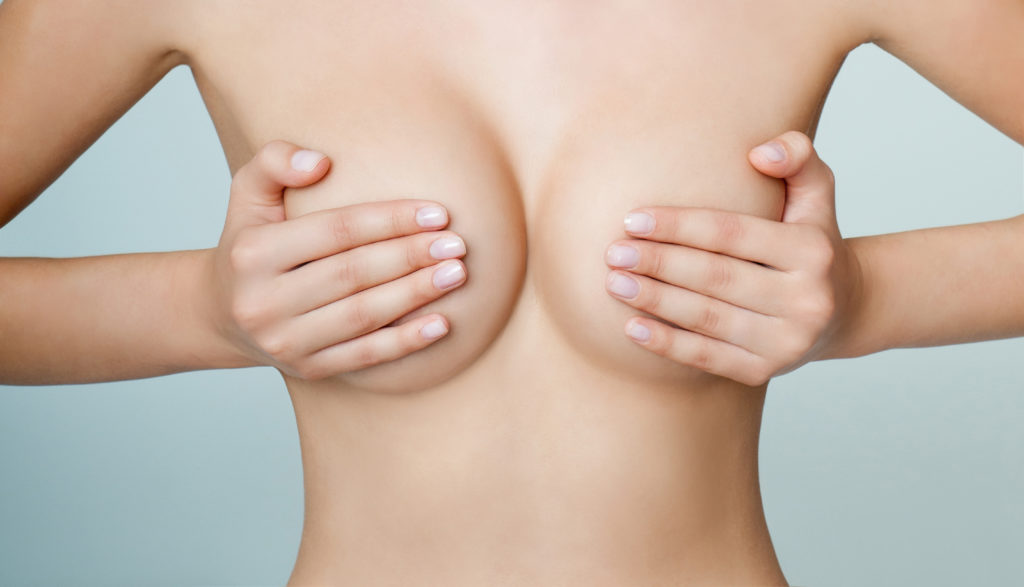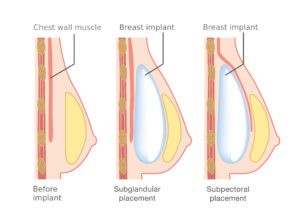¿Pensando en llevar a cabo un Aumento de Pecho en Málaga? En nuestra Clínica de Cirugía Estética en Málaga ponemos a disposición de nuestros clientes nuestro tratamiento: Mamoplastia de aumento, es decir, aumento mamario, más comúnmente conocido como aumento de pecho, un procedimiento quirúrgico para mejorar el tamaño y la forma del pecho de la mujer. La cirugía se basa en la introducción de una prótesis de silicona bajo el pecho de la paciente. Este tipo de intervención puede ser útil para mejorar la silueta de la mujer que presenta unos senos demasiado pequeños, para corregir la reducción del pecho que se produce tras algunos embarazos, para corregir una diferencia de tamaño entre ambas mamas o como procedimiento reconstructivo tras una cirugía de la mama.

Antes de la cirugía
Durante la primera consulta, nuestro equipo médico evaluará el tamaño y la forma de las mamas, la firmeza de la piel y su estado general de salud. Se le explicarán las distintas técnicas quirúrgicas, se discutirá el tamaño y la forma que tendrán sus mamas y las opciones o la combinación de procedimientos que sean mejor para usted. Es muy importante que la paciente exponga sus expectativas de manera sincera y franca, para que los cirujanos plásticos tengan una idea clara y completa de los deseos de la paciente.
Durante la cirugía

La cirugía de mamas se debe realizar en un quirófano preparado, bien sea en un hospital o en una clínica. La cirugía de aumento mamario se realiza bajo anestesia general, es decir, la paciente permanecerá dormida durante la operación. En Clínica Tebon, recomendamos al menos un día de ingreso en el hospital tras esta cirugía.
Para la introducción de la prótesis mamaria, es necesario la realización de una pequeña incisión en la piel de unos 4-5 cm (según el tamaño de la prótesis puede ser mayor o menor). Ésta puede ser diseñada en el surco submamario o alrededor de la areola. Dependiendo de la anatomía de la paciente y sus deseos, nuestros doctores le aconsejarán la mejor vía. A través de esta incisión se levanta el tejido mamario y se crea un bolsillo para la introducción de la prótesis, la cual puede colocarse por encima o por debajo del músculo pectoral. La elección de cada caso dependerá de múltiples factores, como el tipo de pecho de la paciente o la actividad física que realice. Se colocan unos tubos de drenaje que se retirarán en unos días y un apósito o un vendaje sobre las mamas. El procedimiento dura generalmente entre 1 y 2 horas.
Después de la cirugía
Tras la cirugía de aumento de senos, como en otras cirugías, es normal encontrarse algo cansada unos días, pero podrá hacer vida casi normal a los pocos días de la intervención. Es muy importante el reposo de los brazos durante la primera semana, puesto que es necesario favorecer la cicatrización de las prótesis en su lugar correcto. El posible dolor propio de la cirugía se controla bien con la medicación prescrita por nuestros cirujanos plásticos, aunque puede haber pequeñas molestias durante varias semanas. El vendaje será retirado en unos días, siendo sustituido por un sujetador especial, que deberá llevar al menos durante el primer mes. Es normal tener una sensación de ardor en los pezones durante las dos primeras semanas. Los puntos son reabsorbibles, aunque en ocasiones se retiran en torno a los 10-15 días, mientras que la inflamación puede tardar varias semanas en desaparecer completamente.
Tras un aumento mamario podrá volver al trabajo en pocos días, dependiendo de la actividad que realice. Siga las instrucciones de nuestros cirujanos acerca de qué ejercicios puede realizar. Deberá evitar coger peso al menos un mes tras la cirugía. Sus mamas estarán más sensibles de lo normal durante 2 a 3 semanas y las cicatrices irán mejorando a lo largo del primer año.
Las revisiones serán programadas por nuestro equipo de cirujanos plásticos.
Preguntas Frecuentes
La cirugía de aumento mamario es una técnica segura, siempre y cuando sea realizada por un cirujano plástico cualificado. Sin embargo, como en cualquier operación siempre pueden existir complicaciones y riesgos asociados.
La complicación más frecuente es la contractura capsular, que ocurre cuando la cicatriz interna que se forma alrededor del implante se contrae en exceso, haciendo que la mama se vuelva más dura. En ocasiones es muy leve y no requiere tratamiento. En otras, puede ser necesario extirpar dicha cicatriz interna, e incluso, recambiar la prótesis.
Otra complicación es la formación de un hematoma (un sangrado que puede ocurrir en cualquier tipo de cirugía), que sólo en casos concretos precisa de una nueva intervención para eliminar la sangre acumulada. Para prevenir este problema, nuestros cirujanos suelen poner drenajes en quirófano si lo ven preciso.
Un pequeño porcentaje de mujeres puede tener una infección alrededor de la prótesis, normalmente en las primeras semanas después de la cirugía, que en ocasiones se soluciona con tratamiento antibiótico.
Es extraordinariamente infrecuente que las prótesis pueden romperse, haciendo que el contenido salga fuera de su cápsula. La paciente no tiene porqué notar ningún síntoma por ello. Esto no es ninguna emergencia que requiera cirugía urgente, pero será necesario recambiar los implantes.
No existe ninguna contraindicación para hacerse una mamografía llevando implantes mamarios, aunque la paciente deberá avisar al radiólogo de que porta unas prótesis mamarias antes de la prueba.
Después de la cirugía podrás notar molestias en el pecho, pero que serán calmadas con la medicación analgésica prescrita durante el ingreso hospitalario, y posteriormente con la medición vía oral que prescribirán nuestros cirujanos al alta. A la semana de la cirugía, la mayor parte de las pacientes notan únicamente molestias que van cediendo con el tiempo.
Todo procedimiento quirúrgico lleva obligatoriamente la necesidad de crear cicatrices. En al caso del aumento mamario, éstas son mínimas: en el caso de la incisión en el surco, la cicatriz quedará escondida en el mismo; en la incisión periareolar, la cicatriz quedará escondida alrededor de la areola.
En la Clínica Tebon utilizamos prótesis de máxima calidad. Nuestro equipo le informará de los diferentes tipos de prótesis que existen y cuál es mejor para su caso.
No existe fecha de caducidad para las prótesis de alta calidad que ponemos en la Clínica Tebon. Nuestra recomendación es realizar pruebas de imagen de control (ecografía, resonancia…) a partir de los 10 años de la cirugía para ver el estado de los implantes. Si no existen signos de rotura y no tienes ningún síntoma, no es necesario recambiar las prótesis.
Tras un aumento mamario no existe ningún problema para quedarte embarazada o dar lactancia materna a un bebé. La incisión en el surco submamario es la más indicada en caso de querer dar de lactar a un niño, ya que respeta totalmente la glándula mamaria.
Una vez retirados los puntos de sutura, no hay ninguna contraindicación para ir a la playa. Lo más importante es protegerse del sol para que las cicatrices dejen la menor señal posible. Las cicatrices de un aumento mamario suelen ser pequeñas y estar escondidas bajo el surco submamario, lo que las protege aún más de la exposición solar. Deberá, de todas formas, ponerse protector solar total sobre las cicatrices hasta pasado un año de la intervención.
Los días hasta la reincorporación laboral dependerán del trabajo que realices. La primera semana recomendamos siempre estar en casa. A partir de la segunda y tercera semana, dependerá del esfuerzo que tengas que realizar en tu puesto de trabajo: si tienes que llevar cajas o reponer un almacén, por ejemplo, nuestra recomendación es recuperarte durante un mes antes de comenzar el trabajo.
Después de la cirugía de aumento de senos, lo más conveniente es dormir boca arriba con el cabecero de la cama algo elevado al menos durante las dos primeras semanas, aunque nosotros recomendamos como mínimo un mes. Esta posición te protegerá de posibles movimientos nocturnos y disminuirá la inflamación más rápido. Todo lo que sea dormir de lado y boca abajo puede provocar movimientos indeseados de las prótesis sobretodo las primeras semanas, y el desgaste de las mismas con el paso del tiempo.
No existe ninguna contraindicación para poder volar con prótesis mamarias.
